HOW THAT NEW HOUSTON LOOK KEPT MAKING ITS WAY FROM OLD EUROPE 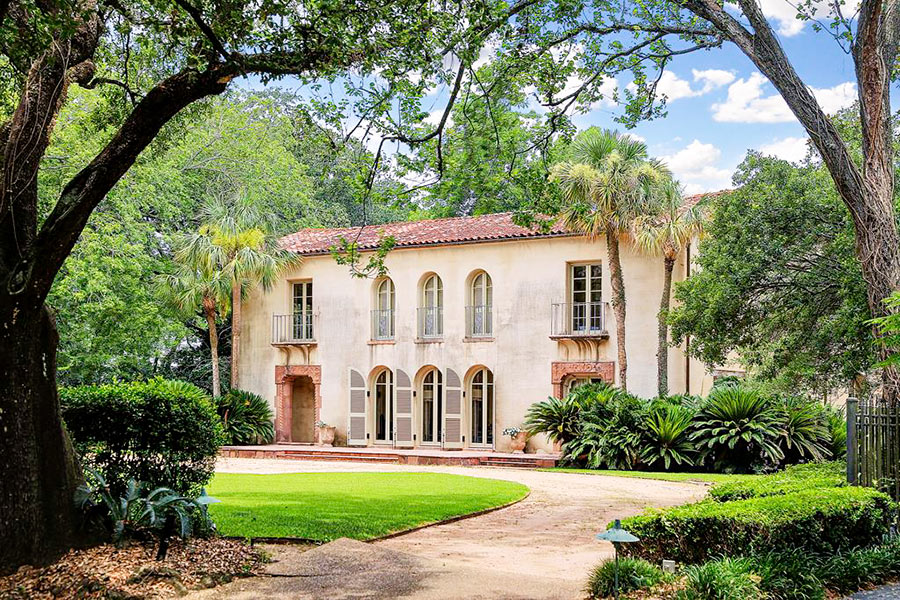 “I have always felt that this North Boulevard house was the one that changed the way Houston looked at decor and antiques,” writes West U design blogger Joni Webb about a stucco mansion in Broadacres by Rice University architect William Ward Watkin, who designed it in 1923 for a drug-company executive after a 4-month inspirational European tour. The property at 1318 North Blvd. later served for more than a decade as the home of Tootsie’s founder Micky Rosmarin, who died after a heart attack last month; it’s now up for sale for $4.75 million. “Back in 1995,” Webb writes, “it was featured on the cover of Veranda and I think it was this house that marked the true beginning of the Houston Look — the white slipcover, seagrass, antique filled aesthetic whose origins I attribute to designer Babs Cooper Watkins . . . it launched Watkins into prominence.” Watkins, Webb explains, “used antiques in a casual way, her interiors were never about a hands-off approach. She mixed in religious relics and priceless antiques with vintage chairs slipcovered in inexpensive plain linen. She repurposed outside garden elements to be used inside the house. And Babs was one of the first ones who favored dramatic paint treatments that turned ordinary sheetrock into centuries old grottos.” Watkins passed away in February of last year. But Webb recalls how the home launched a store — and a whole new Old World orientation for Houston interiors: “The Veranda photoshoot not only created a new aesthetic, it also created a new partnership and the Watkins Schatte antique shop on Bissonnet was born.” The shop (still at 2308 Bissonnet, but now known as Watkins-Culver Antiques) “was an instant hit and during those days, lines would form when a new shipment was unveiled.  Everyone wanted to see what Babs and Bill [Gardner] and Annette [Schatte] had bought in Europe.” [Cote de Texas; previously on Swamplot]
“I have always felt that this North Boulevard house was the one that changed the way Houston looked at decor and antiques,” writes West U design blogger Joni Webb about a stucco mansion in Broadacres by Rice University architect William Ward Watkin, who designed it in 1923 for a drug-company executive after a 4-month inspirational European tour. The property at 1318 North Blvd. later served for more than a decade as the home of Tootsie’s founder Micky Rosmarin, who died after a heart attack last month; it’s now up for sale for $4.75 million. “Back in 1995,” Webb writes, “it was featured on the cover of Veranda and I think it was this house that marked the true beginning of the Houston Look — the white slipcover, seagrass, antique filled aesthetic whose origins I attribute to designer Babs Cooper Watkins . . . it launched Watkins into prominence.” Watkins, Webb explains, “used antiques in a casual way, her interiors were never about a hands-off approach. She mixed in religious relics and priceless antiques with vintage chairs slipcovered in inexpensive plain linen. She repurposed outside garden elements to be used inside the house. And Babs was one of the first ones who favored dramatic paint treatments that turned ordinary sheetrock into centuries old grottos.” Watkins passed away in February of last year. But Webb recalls how the home launched a store — and a whole new Old World orientation for Houston interiors: “The Veranda photoshoot not only created a new aesthetic, it also created a new partnership and the Watkins Schatte antique shop on Bissonnet was born.” The shop (still at 2308 Bissonnet, but now known as Watkins-Culver Antiques) “was an instant hit and during those days, lines would form when a new shipment was unveiled.  Everyone wanted to see what Babs and Bill [Gardner] and Annette [Schatte] had bought in Europe.” [Cote de Texas; previously on Swamplot]
Tag: Antiques
COMMENT OF THE DAY: HOW THE DECLINING MARKET FOR ANTIQUES IS FUELING THE SELF-STORAGE BOOM 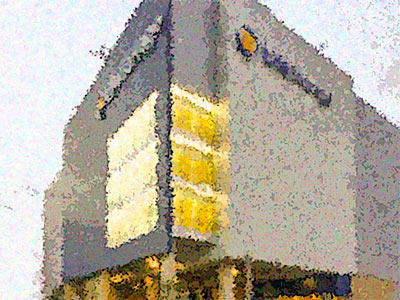 “My mom has an amazing collection of stuff like this. I think about it all the time. . . . worried what I’m going to to with my great great grandfather’s table, and my great grandmother’s silver. I don’t have the room for it at this point in my life . . . but I don’t want to give it away. I almost feel like I need to get a storage unit for it.” [Chef DB, commenting on The Underappreciated Riches of Houston’s Antique Set]
“My mom has an amazing collection of stuff like this. I think about it all the time. . . . worried what I’m going to to with my great great grandfather’s table, and my great grandmother’s silver. I don’t have the room for it at this point in my life . . . but I don’t want to give it away. I almost feel like I need to get a storage unit for it.” [Chef DB, commenting on The Underappreciated Riches of Houston’s Antique Set]
THE UNDERAPPRECIATED RICHES OF HOUSTON’S ANTIQUE SET 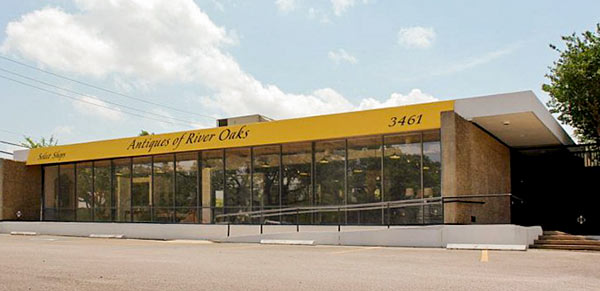 “Someday,” antique dealer and appraiser David Lackey muses to intrepid radio reporter Allison Lee, “the Millennials . . . may be horrified when their children want mahogany furniture and doilies and figurines.” But for now, Lackey seems resigned to the great generational decline — and accompanying price drops — in the market for antique furniture: “There are half as many antique shows in Houston as there were 20 or 30 years ago,” he tells Lee. “Traditional English and American furniture, overall, has fallen maybe 50 to 75 percent.” Lackey operates his business out of the Antiques of River Oaks antiques megashop (pictured above) in the home-furnishings-themed shopping center at 3461 W. Alabama north of Greenway Plaza, but he’s also out and about, soaking up the zeitgeist: “I go into more estates — or I’m working with older people and they’re selling a lot of their stuff because they say their kids and grandkids do not want it. They’ve made it very clear. The younger generation, for the most part, is not very interested in formal candlelight suppers. They don’t want silver, china, crystal, because they don’t intend to entertain that way.†[Houston Public Media] Photo: David Lackey Antiques & Art
“Someday,” antique dealer and appraiser David Lackey muses to intrepid radio reporter Allison Lee, “the Millennials . . . may be horrified when their children want mahogany furniture and doilies and figurines.” But for now, Lackey seems resigned to the great generational decline — and accompanying price drops — in the market for antique furniture: “There are half as many antique shows in Houston as there were 20 or 30 years ago,” he tells Lee. “Traditional English and American furniture, overall, has fallen maybe 50 to 75 percent.” Lackey operates his business out of the Antiques of River Oaks antiques megashop (pictured above) in the home-furnishings-themed shopping center at 3461 W. Alabama north of Greenway Plaza, but he’s also out and about, soaking up the zeitgeist: “I go into more estates — or I’m working with older people and they’re selling a lot of their stuff because they say their kids and grandkids do not want it. They’ve made it very clear. The younger generation, for the most part, is not very interested in formal candlelight suppers. They don’t want silver, china, crystal, because they don’t intend to entertain that way.†[Houston Public Media] Photo: David Lackey Antiques & Art
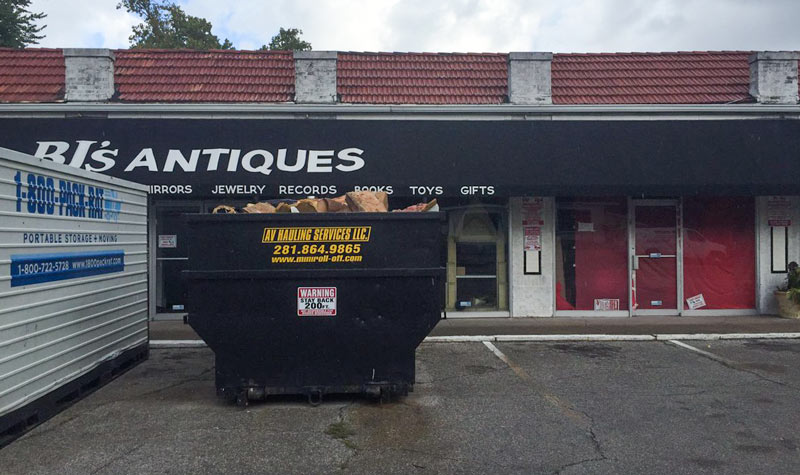
This morning a reader spotted some cleaning out going on at the Westheimer Rd. storefront of BJ’s Oldies Antiques. The shop isn’t closing down, a rep tells Swamplot — just moving next door for a month or so (into the storefront spot formerly occupied by now-on-Taft-St. Cool Stuff) while some building repairs get finished up. The shop’s current location — immediately east of Empire Cafe — is a metal rooster’s throw from where owner Becky Pieniadz ran the business in the 1990s out of a section of the flea market at 1733 Westheimer (directly across the street from Empire). The shop moved down the street for a few years to the building down the road at 1435 Westheimer (currently occupied by bedding store Biscuit) before downsizing back to the 1700 block in 2013.
Photo: Carson LucarelliÂ
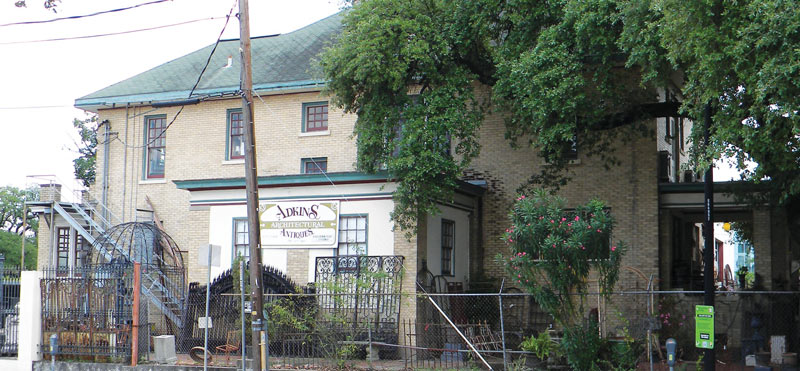
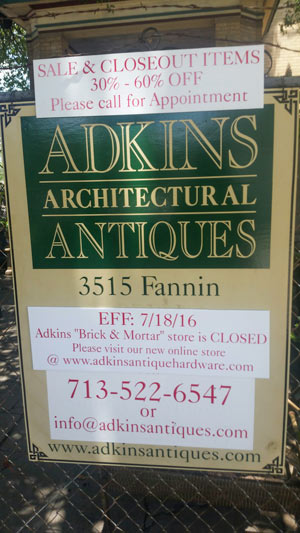 A reader noted these notes near the door of the former home of Adkins Architectural Antiques, which had been operating out of the 100-ish-year-old house at 3515 Fannin (at the corner with Berry St.). The shop is rebranding as Adkins Antique Hardware Co. and retreating from the realm of physical architecture to a fully digital storefront. The company’s inventory also looks to be shifting away from bigger items like salvaged doors and windows to focus in on the little things — like knobs, pulls, and hinges, both old and old-looking. Per the new website, you might still be able to get an in-person appointment as the closing sale wraps up.
A reader noted these notes near the door of the former home of Adkins Architectural Antiques, which had been operating out of the 100-ish-year-old house at 3515 Fannin (at the corner with Berry St.). The shop is rebranding as Adkins Antique Hardware Co. and retreating from the realm of physical architecture to a fully digital storefront. The company’s inventory also looks to be shifting away from bigger items like salvaged doors and windows to focus in on the little things — like knobs, pulls, and hinges, both old and old-looking. Per the new website, you might still be able to get an in-person appointment as the closing sale wraps up.
The property itself was listed for lease on LoopNetabout 2 weeks ago, under its HCAD alter ego of 1103 Berry. The house and its early-1990s warehouse are the only structures on the block, which otherwise serves as parking lot. CBRE’s leasing flier aerial (below) shows the space bathed in green highlighting, in place between the Ensemble Theater, several Houston Community College buildings, that Holman-St.-facing strip center, and the Downtown Pregnancy Help Center (thought the fact that it doesn’t show much progress on the recently-wrapped MATCH building dates the shot):
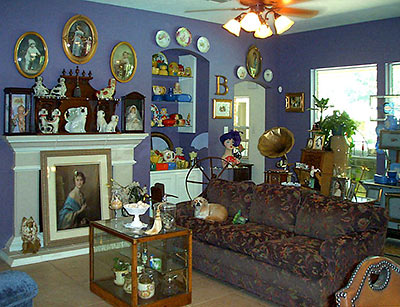
Sorry, all the furnishings shown here don’t come with. Which is sad, really, because if this is just the kind of place you’d like to live in, you’ll have to find each of these items on your own. This 5-bedroom, 3,075-sq.-ft. 10-year-old fully tiled house in Crighton Ridge — on the not-The-Woodlands side of I-45 — went on the market last week for $359,500.
HARTS GOING, GOING, GOING . . . TO PRISON  Auctioneers and swindlers Jerry and Wynonne Hart will begin serving their 14-year prison sentences “within days,” after an appeals court reversed a decision that would have given the former owners of the Hart Galleries on South Voss a new trial. The Harts pled guilty to “misapplication of fiduciary property” 2 years ago, in return for prosecutors dropping theft and money-laundering charges against them. Prosecutors claim the Harts sold customers’ goods at auction but regularly underpaid or otherwise finagled their way out of distributing the proceeds. [Houston Chronicle; previously on Swamplot] Photo: Hart Galleries
Auctioneers and swindlers Jerry and Wynonne Hart will begin serving their 14-year prison sentences “within days,” after an appeals court reversed a decision that would have given the former owners of the Hart Galleries on South Voss a new trial. The Harts pled guilty to “misapplication of fiduciary property” 2 years ago, in return for prosecutors dropping theft and money-laundering charges against them. Prosecutors claim the Harts sold customers’ goods at auction but regularly underpaid or otherwise finagled their way out of distributing the proceeds. [Houston Chronicle; previously on Swamplot] Photo: Hart Galleries
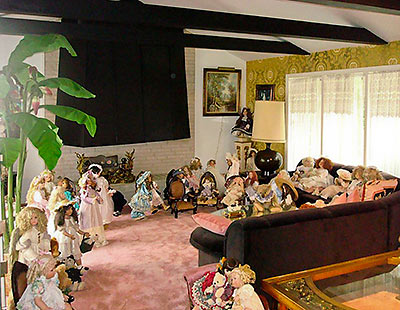
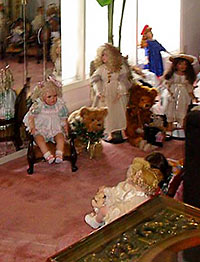 “Wanna play?” asks the reader who clued Swamplot in to the nonstop . . . uh, doll party going on at this house in Braeburn Valley.
“Wanna play?” asks the reader who clued Swamplot in to the nonstop . . . uh, doll party going on at this house in Braeburn Valley.
Why, yes, you’re invited! Won’t you stop by for a visit?

Swamplot’s Candace Garcia sends in these pix of the scene on the north side of Westheimer between Park St. and Dunlavy, the morning after a Halloween inferno destroyed an antique store and the Agora cafe next door. There’s not much left to shop for at Gordon Greenleaf’s Antique Warehaus at 1714 Westheimer, a woodframe residence pressed into used-furniture service more than 50 years ago. That’s where the fire started shortly after midnight Sunday morning. Agora’s brick structure appears to have fared better, and may be rebuilt. Everyone in the 2-story cafe was able to get out safely, but 2 firefighters were later treated for heat exhaustion. “Thanks to the Halloween holiday it was one of the most well-documented fires in recent Houston history,” writes the Houston Press’s Craig Hlavaty, who watched the flames from across the street, dressed in drag, along with a small crowd of participants in the Montrose Costume Crawl — none of them dressed as firefighters.
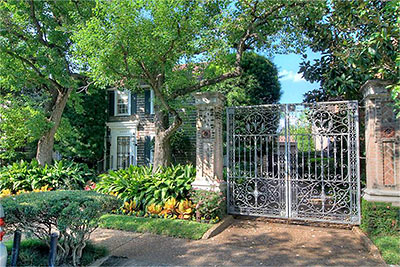
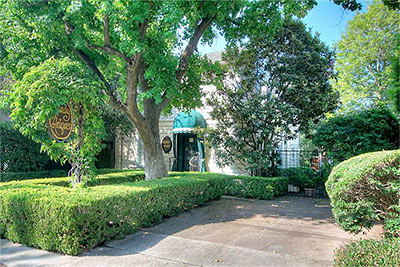
Longtime Ferndale resident Carol Barden (yes, that Carol Barden) clues us into the recent appearance on MLS — at $549K apiece — of 2 out of the 3 wood-frame residences that now make up Jas Gurney Antiques. “It’s such a great little street,” she writes. “All the neighbors are so afraid that some awful developer will demo the houses and build junk. Jas has maintained gardens, old-growth trees, he plants flowers for every season.” Gurney reportedly would prefer to sell his entire inventory of “museum-quality” antiques along with his houses, but hasn’t been able to find a buyer. Also on that mixed-residential stretch of Ferndale, between Westheimer and Alabama: townhouses, plain ol’ houses, 4 more antique stores, Jill Brown’s lighting store, plus several more businesses.
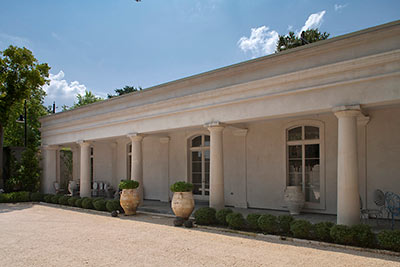
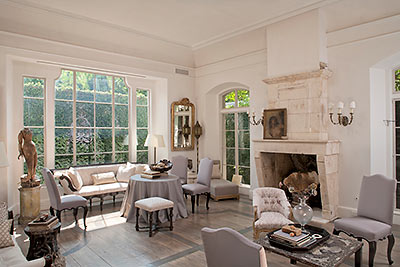
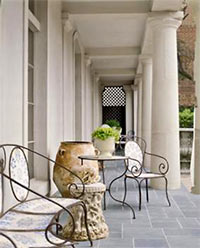 Included among the 9 new or newish architect-designed homes on this year’s AIA home tour this weekend: 3 properties that made recent cameo appearances on Swamplot. Shown here: the one-room-deep one-bedroom home Kay O’Toole had built behind her “antiques & eccentricities” store at 1921 Westheimer, next to Winlow Place. Did you know it was hiding back there? The design by Murphy Mears Architects — with interiors by the owner — showed up in Veranda magazine and (far more notably) in one of those extensive Cote de Texas posts earlier this year.
Included among the 9 new or newish architect-designed homes on this year’s AIA home tour this weekend: 3 properties that made recent cameo appearances on Swamplot. Shown here: the one-room-deep one-bedroom home Kay O’Toole had built behind her “antiques & eccentricities” store at 1921 Westheimer, next to Winlow Place. Did you know it was hiding back there? The design by Murphy Mears Architects — with interiors by the owner — showed up in Veranda magazine and (far more notably) in one of those extensive Cote de Texas posts earlier this year.
What about something a little more Modern-looking? And maybe a little more . . . available?
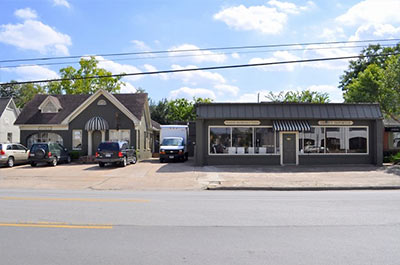
This string of antique-store buildings on West Alabama just east of Shepherd has been on the market since last fall. Swamplot noted the Brian Stringer Antiques 40-percent-off going-out-of-business sale in December, but the 25-percent-off sale on the buildings began only last month, after a second price reduction. The bungalow, showroom, and 2-story warehouse on the 14,004-sq.-ft. lot are now priced at $1,099,000. The listing notes the store and its inventory are also for sale “for additional consideration.”
“Everyone in Houston knows the shopping ritual here,” explained ritual antique shopper Joni Webb last year. “You go [through] the main showroom first, work your way to the back storeroom, stop at the side showroom, then exit through the metal garage door to go outside where you then enter the little French house through its side door.”
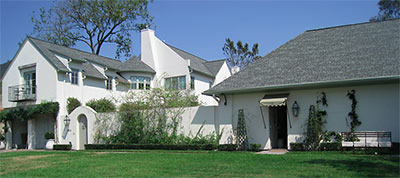
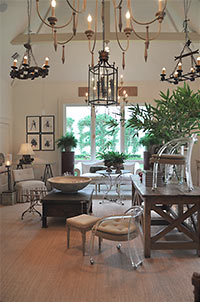
Today, tomorrow, and Thursday are the final days for The Fabulous Flea: After this sale, shop owner Mary Daly and her husband hope to sell the little Bammel Lane antique store — along with their cozy 4,018-sq.-ft. house next door. The compound, designed by Kurt Aichler, also includes a pool, an open-air poolhouse, and a small collection of courtyards on a 15,000-sq.-ft. lot.
The whole 4-6 bedroom, 3-1/2-bath package is priced at $1,995,000. But you might be able to find a few pieces of furniture for a little less than that at the shop’s final sale this week:
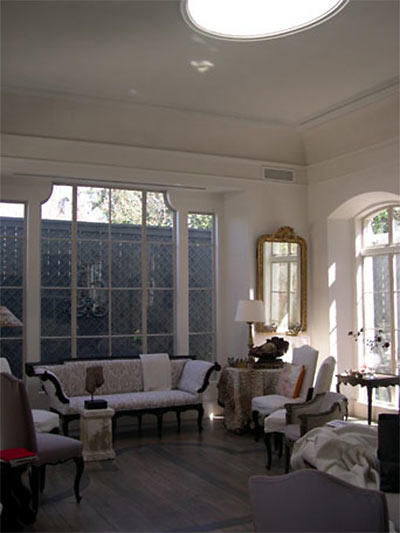
Ubiquitous design blogger Joni Webb hyperventilates over the March issue of Veranda magazine, which features actual interior pics of the house Kay O’Toole had built behind her Kay O’Toole Antiques & Eccentricities shop. The shop is in the building with the rounded corners next to the Firkin & Phoenix Pub parking lot at 1921 Westheimer:
I had heard the blogosphere mumbling about this Veranda showing Kay O’Toole’s new house and that was what had my mouth watering like Edward’s whenever Bella is around. Honestly, I’ve been waiting over two years for this issue!
O’Toole owns a French antique shop housed in a 1920s brick building that was once home to several different businesses. Through the years, she eventually acquired the entire building and tore down the dividing walls – creating a long and narrow haven for the best of what France, and now Belgium, Sweden, and Italy have to offer.
O’Toole’s single-story, one-bedroom stucco home — designed by Murphy Mears Architects — is another long and narrow haven, modeled after something O’Toole saw in New Orleans’s French Quarter: It’s one room deep, and backs up to the property’s back fence.
Couldn’t Webb have just charmed her way inside, camera in hand? Oh, she’d tried that:
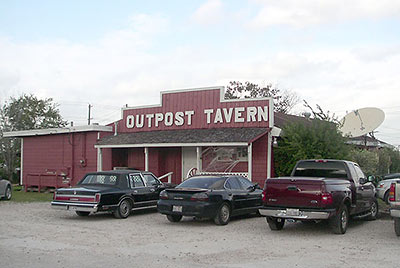
A quick roundup:
- Closing in January: NASA hangout the Outpost Tavern, an army barracks building turned spacesuit-and-bikini-festooned party site, down NASA Rd. 1 from the Johnson Space Center at 18113 Kings Lynn St. Memorialized in the appropriately named Clint Eastwood “one last time for the has-been astronauts” flick Space Cowboys, the bar and burger joint had to be partially rebuilt in early 2005 after a short in a neon sign caused a small fire. Second-generation owner Stephanie Foster reports the property has been sold to new owners who “plan to build something new on the site, perhaps a service station or shopping center.” Fans of the Outpost Tavern’s many good ol’ days will drown their sorrows on-site in a 3-day-long goodbye-party bash, January 8-10.
- Closed, Just a Month After Opening: The new 7,000-sq.-ft. prototype Bailey Banks & Biddle store in CityCentre. The new owners of the former Zales mall mainstay declared bankruptcy in August, but went ahead with the store’s planned move from its old location across the street at Town & Country Village anyway. Other local Triple Bs didn’t get the grand-opening treatment before going dark: “The Galleria and Willowbrook Mall locations are in liquidation, while The Woodlands Mall store and the new CityCentre location are expected to go dark on Dec. 24 following liquidation sales, according to store employees.”
- Open Only for One Last Big Sale: Brian Stringer Antiques, strung along West Alabama just east of Shepherd in a few separate buildings for the last 40 or so years. Stringer and his wife will retire to their turreted 14th century chateau — a former fortified hospital built by monks for victims of a mysterious skin disease — in the French countryside between Bordeaux and Gers. But lucky us, they’ll stick around Houston long enough to sell the majority of their stock of European antiques, reproductions, and fabrics at 40 percent off, Joni Webb reports: “The French house is so charming – you really feel like you’re in the South of France, except for Houston’s traffic out the front window!” When you’re done shopping there, Webb commands:
be sure to also stop in at Ginger Barber’s Sitting Room which is next door. Further up the street is Tara Shaw and Heather Bowen Antiques. Continue up W. Alabama to Antiques and Interiors on Dunlavy, Boxwood and The Country Gentleman, then hit up Foxglove and Alcon Lighting.
If you haven’t passed out from exhaustion yet, turn around and head back to Brian Stringer’s and go the other way on W. Alabama. Stop at Jane Moore’s, then at Ferndale, go to Brown, Bill Gardner, Made in France, and Objects Lost and Found. Back on W. Alabama, continue on to Thompson and Hansen, The Gray Door, Chateau Domingue, Indulge on Saint Street, and 2620 on Joanel.
More openings and closings:

